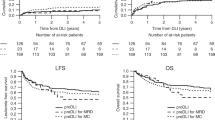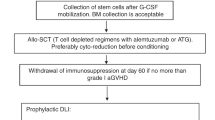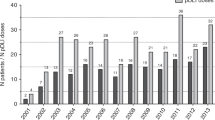Abstract
An increasing percentage of autologous cells (increasing chimerism) in the whole blood (WB) chimerism test following allogeneic transplant is related to a very high risk of relapse. Preemptive immunotherapy may decrease the risk of relapse in some patients. Our prospective multi-institutional study evaluated the feasibility of longitudinal chimerism testing in a central laboratory, compared WB, CD3+ and leukemia-specific lineage chimerism in patients with a variety of hematologic malignancies, and evaluated the feasibility of fast withdrawal of immunosuppression based on WB chimerism results. Centralized chimerism testing was feasible and showed low interassay variability. Increasing mixed chimerism (MC) in WB was not useful as a predictor of relapse in our study. The presence of full donor chimerism in WB, CD3+ and leukemia-specific lineages on all measurements was related to a significantly lower risk of relapse than the presence of MC in either subset (11 vs 71%, respectively; P=0.03). Increasing host chimerism in leukemia-specific lineage heralds relapse, but it was not detected early enough to allow immunotherapy. Further studies correlating lineage-specific chimerism and minimal residual disease are required. The goal of preemptive immunotherapy should be to achieve full donor chimerism in WB in CD3+ and leukemia-specific lineages.
This is a preview of subscription content, access via your institution
Access options
Subscribe to this journal
Receive 12 print issues and online access
$259.00 per year
only $21.58 per issue
Buy this article
- Purchase on Springer Link
- Instant access to full article PDF
Prices may be subject to local taxes which are calculated during checkout
Similar content being viewed by others
References
Bader P, Beck J, Frey A, Schlegel PG, Hebarth H, Handgretinger R et al. Serial and quantitative analysis of mixed hematopoietic chimerism by PCR in patients with acute leukemias allows the prediction of relapse after allogeneic BMT. Bone Marrow Transplant 1998; 21: 487–495.
Bader P, Kreyenberg H, Hoelle W, Dueckers G, Kremens B, Dilloo D et al. Increasing mixed chimerism defines a high-risk group of childhood acute myelogenous leukemia patients after allogeneic stem cell transplantation where pre-emptive immunotherapy may be effective. Bone Marrow Transplantation 2004; 33: 815–821.
Bader P, Klingebiel T, Schaudt A, Theurer-Mainka U, Handgretinger R, Lang P et al. Prevention of relapse in pediatric patients with acute leukemia and MDS after allogeneic SCT: a single center experience of 12 children. Leukemia 1999; 13: 2079–2086.
Gorczynska E, Turkiewicz D, Toporski J, Kalwak K, Rybka B, Ryczan R et al. Prompt initiation of immunotherapy in children with an increasing number of autologous cells after allogeneic HCT can induce complete donor-type chimerism: a report of 14 children. Bone Marrow Transplant 2004; 33: 211–217.
Barrios M, Jimenez-Velasco A, Roman-Gomez J, Madrigal ME, Castillejo JA, Torres A et al. Chimerism status is a useful predictor of relapse after allogeneic stem cell transplantation for acute leukemia. Haematologica 2003; 88: 801–810.
Bader P, Stoll K, Huber S, Geiselhart A, Handgretinger R, Niemeyer C et al. Characterization of lineage-specific chimaerism in patients with acute leukemia and myelodysplastic syndrome after allogeneic stem cell transplantation before and after relapse. Br J Hematol 2000; 108: 761–768.
Bader P, Kreyenberg H, Hoelle W, Dueckers G, Handgretinger R, Lang P et al. Increasing mixed chimerism is an important prognostic factor for unfavorable outcome in children with acute lymphoblastic leukemia after allogeneic stem-cell transplantation: Possible role for pre-emptive immunotherapy? J Clin Oncol 2004; 22: 1696–1706.
Bader P, Niemeyer C, Willasch A, Kreyenberg H, Strahm B, Kremens B et al. Children with myelodysplastic syndrome (MDS) and increasing mixed chimaerism after allogeneic stem cell transplantation have a poor outcome which can be improved by pre-emptive immunotherapy. Br J Hematol 2005; 128: 649–658.
Yoshimi A, Niemeyer C, Bohmer V, Duffner U, Strahm B, Kreyenberg H et al. Chimerism analyses and subsequent immunological intervention after stem cell transplantation in patients with juvenile myelomonocytic leukemia. Br J Hematol 2005; 129: 542–549.
Huisman C, Weger RA, de Vries L, Tilanus MGJ, Verdonck LF . Chimerism analysis within 6 months of allogeneic stem cell transplantation predicts relapse in acute myeloid leukemia. Bone Marrow Transplant 2007; 39: 285–291.
Mattson J, Uzunel M, Tammik L, Aschan J, Ringden O . Leukemia lineage-specific chimerism analysis is a sensitive predictor of relapse in patients with acute myeloid leukemia and myelodysplastic syndrome after allogeneic stem cell transplantation. Leukemia 2001; 15: 1976–1985.
Gardiner N, Lawler M, O'Riordan JM, Duggan C, De Arce M, McCann SR . Monitoring of lineage-specific chimaerism allows early prediction of response following donor lymphocyte infusions for relapsed chronic myeloid leukemia. Bone Marrow transplant 1998; 21: 711–719.
Zetterquist H, Mattsson J, Uzunel M, Nasman-Bjork I, Svenberg P, Tammik L et al. Mixed chimerism in the B cell lineage is a rapid and sensitive indicator of minimal residual disease in bone marrow transplant recipients with pre-B cell acute lymphoblastic leukemia. Bone Marrow Transplant 2000; 25: 843–851.
Miura Y, Tanaka J, Toubai T, Tsutsumi Y, Kato N, Hirate D et al. Analysis of donor-type chimerism in lineage-specific cell populations after allogeneic myeloablative and nonmyeloablative stem cell transplantation. Bone Marrow Transplant 2006; 37: 837–843.
Zeiser R, Spyridonidis A, Wasch R, Ihorst G, Grullich C, Bertz H et al. Evaluation of immunomodulatory treatment based on conventional and lineage-specific chimerism analysis in patients with myeloid malignancies after myeloablative allogeneic hematopoietic cell transplantation. Leukemia 2005; 19: 814–821.
Scharf S, Smith A, Hansen J, McFarland C, Erlich H . Quantitative determination of bone marrow transplant engraftment using fluorescent polymerase chain reaction primers for human identity markers. Blood 1995; 85: 1954–1963.
Przepiorka D, Wiesdorf D, Martini P, Klingemann HG, Beatty P, Hows J et al. 1994 consensus conference on acute GVHD grading. Bone Marrow Transplant 1995; 15: 825–828.
Shulman HM, Sullivan KM, Weiden PL, McDonald GB, Striker GE, Sale GE et al. Chronic graft-versus-host syndrome in man: long-term clinicopathologic study of 20 Seattle patients. Am J Med 1980; 69: 204–217.
Lutz C, Massenkeil G, Nagy M, Neuburger S, Tamm I, Rosen O et al. A pilot study of prophylactic donor lymphocyte infusions to prevent relapse in adult acute lymphoblastic leukemias after allogeneic hematopoietic stem cell transplantation. Bone Marrow Transplant 2008; 41: 805–812.
Lim ZY, Pearce L, Ingram W, Ho AYL, Mufti GJ, Pagliuca A . Chimerism does not predict for outcome after alemtuzumab-based conditioning: lineage-specific analysis of chimerism of specific diseases may be more informative. Bone Marrow Transplant 2008; 41: 587–588.
Kerst G, Kreyenberg H, Roth C, Well C, Dietz K, Coustan-Smith E et al. Concurrent detection of minimal residual disease (MRD) in childhood acute lymphoblastic leukaemia by flow cytometry and real-time PCR. Br J Haematol 2005; 108: 774–782.
Koldehoff M, Steckel N, Hlinka M, Beelen D, Elmaagacli A . Quantitative analysis of chimerism after allogeneic stem cell transplantation by real-time polymerase chain reaction with single nucleotide polymorphisms, standard tandem repeats, and y-chromosome specific sequences. Am J Hematol 2006; 81: 735–746.
Willasch A, Schneider G, Reincke BS, Shayegi N, Kreyenberg H, Kuci S et al. Sequence polymorphism systems for quantitative real-time polymerase chain reaction to characterize hematopoietic chimerism—High informativity and sensitivity as well as excellent reproducibility and precision of measurement. Lab Hematol 2007; 13: 73–84.
Acknowledgements
We would like to acknowledge the financial support provided by the Hellman Family Grant, which covered the expenses of chimerism testing for this study.
We thank Dr Stephen Grupp and Dr John Levine from the Stem Cell Sources Strategy Group of Pediatric Blood and Marrow Transplant Consortium for reviewing this study, offering their advice and their help in initiating multi-institutional cooperation, which made the study possible. We would also like to acknowledge the members of UCSF Immunogenetic Laboratory: Denice Kong, Victor Corpuz and David Sidebottom for their technical support and help in study coordination.
Author information
Authors and Affiliations
Corresponding author
Rights and permissions
About this article
Cite this article
Horn, B., Soni, S., Khan, S. et al. Feasibility study of preemptive withdrawal of immunosuppression based on chimerism testing in children undergoing myeloablative allogeneic transplantation for hematologic malignancies. Bone Marrow Transplant 43, 469–476 (2009). https://doi.org/10.1038/bmt.2008.339
Received:
Revised:
Accepted:
Published:
Issue Date:
DOI: https://doi.org/10.1038/bmt.2008.339
Keywords
This article is cited by
-
Chimerism analysis for clinicians: a review of the literature and worldwide practices
Bone Marrow Transplantation (2022)
-
Intensive monitoring of minimal residual disease and chimerism after allogeneic hematopoietic stem cell transplantation for acute leukemia in children
Bone Marrow Transplantation (2021)
-
Monitoring minimal residual/relapsing disease after allogeneic haematopoietic stem cell transplantation in adult patients with acute lymphoblastic leukaemia
Bone Marrow Transplantation (2020)
-
Effects of preemptive interferon-α monotherapy in acute leukemia patients with relapse tendency after allogeneic hematopoietic stem cell transplantation: a case-control study
Annals of Hematology (2018)
-
Impact of T-cell chimerism on relapse after cord blood transplantation for hematological malignancies: Nagoya Blood and Marrow Transplantation Group study
Bone Marrow Transplantation (2017)



